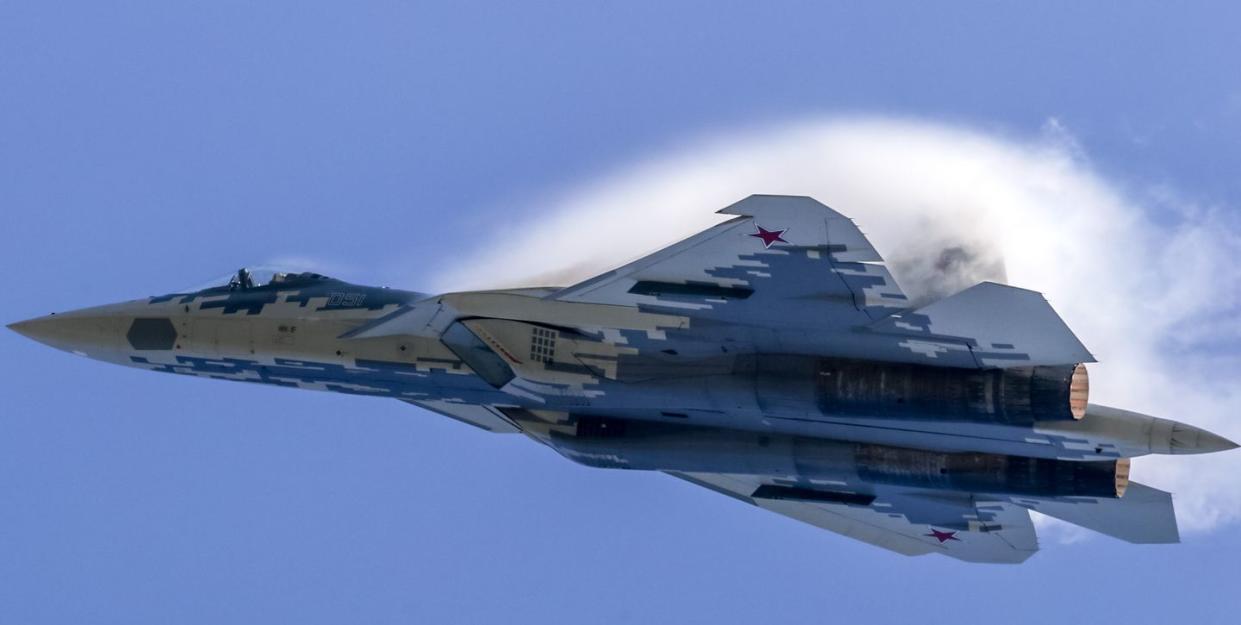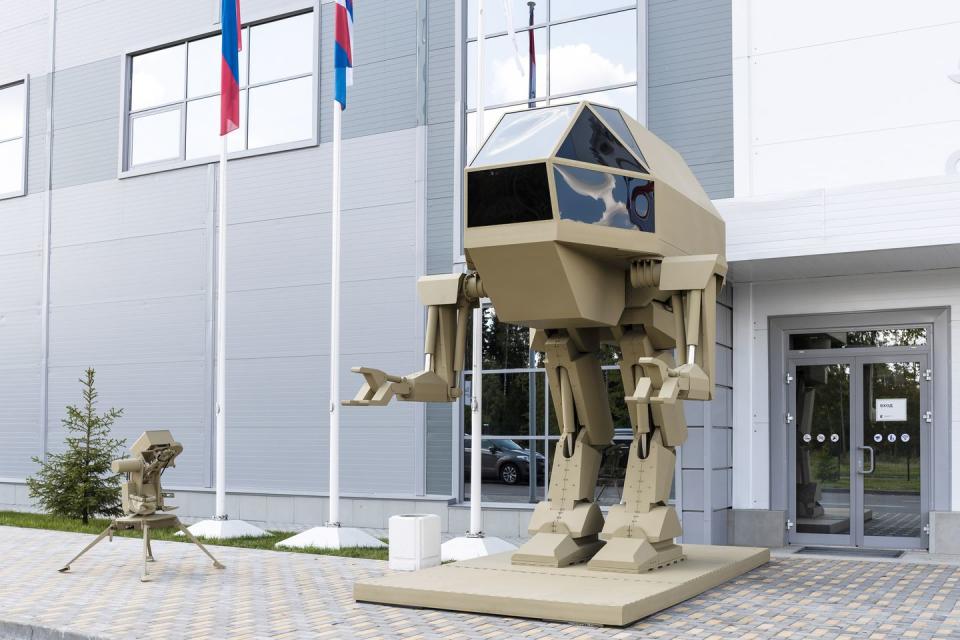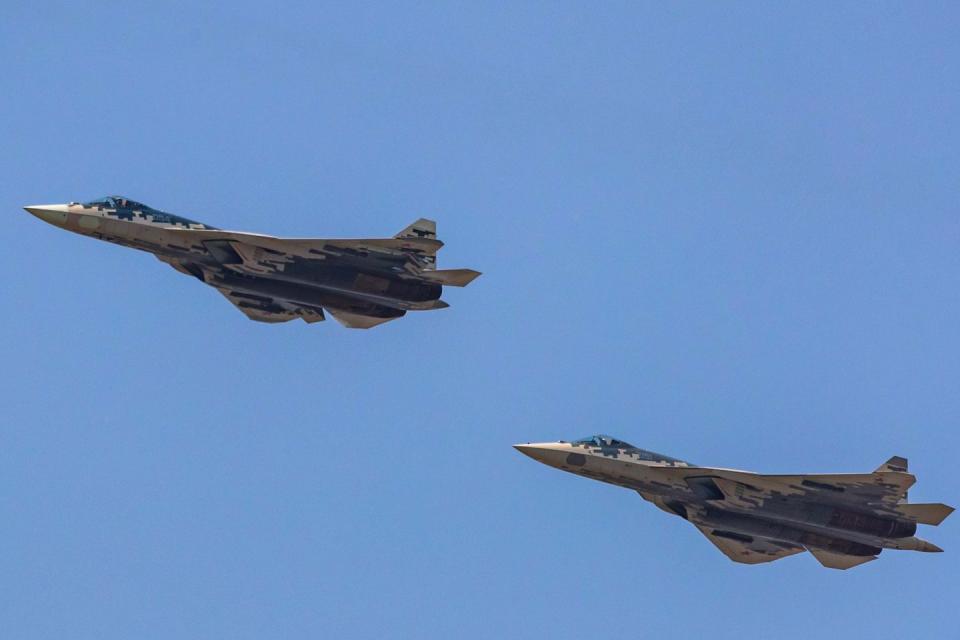Russia Is Struggling in Ukraine. So Where Are Its So-Called Wonder Weapons?

Russia has announced various new high-tech weapons over the past five years.
The weapons included a mecha, a fifth-generation fighter jet, a new tank, a robotic fighting vehicle, and a hypersonic missile.
Only one of those weapons has made an appearance in the war in Ukraine so far.
Russia’s invasion of Ukraine is in trouble. Eight months into the war, Russian forces have been forced out of half of the territory conquered in the spring. Moscow is in the embarrassing position of being on the defensive in a war of its own creation.
The war has made it clear the Russian Armed Forces were deeply flawed from the start, lacking practically everything—including modern equipment.
🎖️ Don’t miss any of our best-in-class military and defense news. Join our squad with Pop Mech Pro.
Russia’s poor performance prompts the question: Whatever happened to Putin’s vaunted “wonder weapons?” Russia announced several revolutionary new weapons systems in the years leading up to the war, from human-piloted combat walkers to robotic tanks, yet eight months in hardly any of them have seen combat.
It’s time for a dive into the world of Russian military vaporware.
T-14 Armata Main Battle Tank

Today’s Russian tanks, including the T-72B1, T-72B3, T-80BVM, and newer T-90 series, all trace their lineage to the original T-72 main battle tank—and inherit all of the tank’s flaws. The T-14 Armata tank, introduced in 2015, was supposed to fix that. A clean sheet tank design, Armata was a new tank designed to break with the old and included a 125-millimeter gun, Afghanit active protection system, and even nuclear shells. Russia, as part of its GPV 2020 rearmament program, was supposed to build 2,000 Armata tanks by 2020.
In August 2021, Russian state media announced that 20 Armatas would be delivered by the end of the year. The new tank is reportedly more expensive than originally believed. Many of the components, even LCD displays for the crew, were imported and their sourcing was crippled by sanctions imposed by the West over the 2015 invasion of Crimea. While Russia has rushed 60-year-old T-62 tanks to the frontline, the Armata is still a no-show, suggesting that even if the ground forces really do have 20 tanks, they’re not combat-ready.
Igorek Combat Walker Mecha

One of the most unusual of the wonder weapons was Igorek, a “controlled bipedal walker” that made its debut in 2018. Igorek was developed by Kalashnikov, a Russian arms maker that took its name from the designer of the AK-47, Mikhail T. Kalashnikov. The gold-painted combat walker made its debut at the Army 2018 weapons expo, held every two years just outside Moscow.
Igorek, to no one’s surprise, has neither been seen nor heard from in more than four years. Combat walkers as a concept are flawed, and the locomotion capability would likely need years of development to be practical on the battlefield. It’s likely that the entire system was a publicity stunt meant to make people think differently about the Kalashnikov brand, which is mostly associated with Russia, guerrilla movements worldwide, and street gangs.
Uran-9 Robotic Combat Vehicle

In the late 2010s, Russia was known to be behind the West in the development of robotic combat systems. Then, out of nowhere, the Uran-9 robotic combat vehicle appeared in 2016. The tracked robot, about the size of a small truck, boasted a 30-millimeter gun, anti-tank missiles, and a 7.62-mm machine gun. Uran-9 was a hint at a future where a single Russian soldier could effortlessly operate robotic tanks from behind friendly lines, wrecking enemy tanks costing many times more.
By all accounts, that future was and still is science fiction. In 2018, Uran-9 was deployed alongside Russian forces in Syria, where the robo-tank struggled to maintain a wireless connection to its human controllers. There have been zero sightings of Uran-9 in Ukraine since the war began, a curious absence considering Russia is facing acute manpower problems, and a working robotic combat vehicle would help alleviate them. Uran-9’s absence from the war suggests technical problems were even worse than originally reported.
Su-57 “Felon” Fighter Jet

Russia for the most part relies on fighters that are updates of Soviet, Cold-War-era fighters. The Sukhoi Su-57, known to NATO as the “Felon,” was intended as the first fighter of the new Russia. A fifth-generation fighter packed with a powerful radar, long-range air-to-air missiles, stealth, and engines that allowed it to cruise above the speed of sound, it was a direct challenge to the American F-22 Raptor.
The Su-57 was first introduced in 2010. Twelve years later, the Russian Aerospace Forces are believed to have between six and 15 Su-57s, out of the hundreds that were planned. A lack of funding for development is blamed, particularly India’s withdrawal from a program to develop a combat-worthy jet. Su-57s have been entirely absent from Ukrainian airspace.
Kinzhal Air-Launched Hypersonic Weapon

In 2018, Russian President Vladimir Putin announced five new nuclear delivery systems. One of these was the Kinzhal, a hypersonic missile launched from a modified MiG-31 Foxhound fighter jet. Kinzhal would be able to deliver both conventional and nuclear payloads at speeds exceeding Mach 5, placing NATO ground targets and even aircraft carriers at risk.
Kinzhal is the only one of Putin’s wonder weapons to see combat in Ukraine, and it made such a minimal impact it was initially unclear if Russia had actually used them. U.S. Secretary of Defense Lloyd Austin also said he would not see the use of Kinzhal as a “game-changer.” Multiple sources later told CNN that the Kinzhal’s use in Ukraine was a warning to NATO, but the utter lack of effect it has had on the course of the war makes it not much of one.
You Might Also Like

